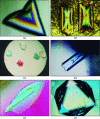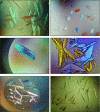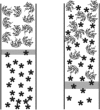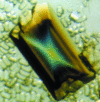Introduction to protein crystallization
- PMID: 24419610
- PMCID: PMC3943105
- DOI: 10.1107/S2053230X13033141
Introduction to protein crystallization
Abstract
Protein crystallization was discovered by chance about 150 years ago and was developed in the late 19th century as a powerful purification tool and as a demonstration of chemical purity. The crystallization of proteins, nucleic acids and large biological complexes, such as viruses, depends on the creation of a solution that is supersaturated in the macromolecule but exhibits conditions that do not significantly perturb its natural state. Supersaturation is produced through the addition of mild precipitating agents such as neutral salts or polymers, and by the manipulation of various parameters that include temperature, ionic strength and pH. Also important in the crystallization process are factors that can affect the structural state of the macromolecule, such as metal ions, inhibitors, cofactors or other conventional small molecules. A variety of approaches have been developed that combine the spectrum of factors that effect and promote crystallization, and among the most widely used are vapor diffusion, dialysis, batch and liquid-liquid diffusion. Successes in macromolecular crystallization have multiplied rapidly in recent years owing to the advent of practical, easy-to-use screening kits and the application of laboratory robotics. A brief review will be given here of the most popular methods, some guiding principles and an overview of current technologies.
Keywords: IYCr; crystallization; proteins.
Figures













References
-
- Abel, J. J., Geiling, E. M. K., Roultier, O. A., Bell, F. M. & Wintersteiner, O. (1927). Crystalline insulin. J. Pharmacol. Exp. Ther. 31, 65–85.
-
- Bailey, K. (1942). The growth of large single crystals of proteins. Faraday Soc. Trans. 38, 186–192.
-
- Bard, J., Ercolani, K., Svenson, K., Olland, A. & Somers, W. (2004). Automated systems for protein crystallization. Methods, 34, 329–347. - PubMed
-
- Bergfors, T. M. (1999). Protein Crystallization: Techniques, Strategies, and Tips La Jolla: International University Line.
-
- Bergfors, T. (2003). Seeds to crystals. J. Struct. Biol. 142, 66–76. - PubMed
Publication types
MeSH terms
Substances
LinkOut - more resources
Full Text Sources
Other Literature Sources

